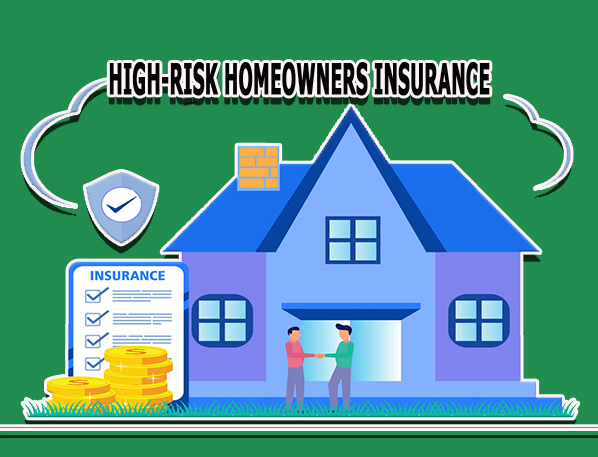Purchasing a standard homeowners insurance policy can be challenging, but the process becomes more difficult if the insurer determines that you or your property poses a high risk. High-risk homeowners insurance covers various risk factors, including recent claims and frequent natural disasters in your area. Insurers may deny coverage, increase premiums, or exclude certain risks based on the risks you and your property pose.

Homeowners insurance companies consider the high risk of filing a claim, the nature of the claim, and the associated expenses when determining coverage. Additionally, factors considered include the homeowner’s financial history and claim history in addition to the property’s location and condition. Certain households, despite higher premiums and constrained coverage, may still be eligible for a policy despite being considered higher-risk households. To bridge the gap, in addition to conventional insurers, there are alternative providers and state-run initiatives.
What Makes Homeowners Insurance High-Risk
Numerous elements, both personal and property-related, may cause insurers to view your house as a higher risk. Personal characteristics like aggressive pet breed, low credit scores, and multiple claim filings can influence an individual’s risk status. Furthermore, your house’s age, the presence of a swimming pool, or an older roof may pose risks to you.
Some typical explanations why homeowners insurance is considered high risk are because;
Poor credit rating
Your insurance score is determined by your credit history, just like a regular credit score. In most states, the insurance company’s decision to write a policy or its cost is influenced by your credit score. Among the states that limit the use of credit scores in approval or rates are California, Maryland, Massachusetts, Michigan, and Oregon.
Past claim history
You may find it more difficult to obtain coverage or pay more for it if you have filed numerous claims. The CLUE report, which contains your claims history for the previous seven years, is reviewed by insurers for applicants.
Pets
Insurance companies may exclude certain dog breeds or prioritize dogs with a history of biting or dangerous behavior. Any exotic, wild, and non-domesticated animals with a propensity for aggressive behavior could also fall under this category and be kept in the house.
Factors That Make a Home High Risk
A home may need high-risk home insurance due to several factors, including its type and condition, its location in a high-risk area, etc. In assessing a residence, insurance providers might take into account:
High-risk features
Although having a swimming pool can make you the talk of the neighborhood, there is a considerable chance that you could get hurt and that someone could file a claim. If a child entered their pool without authorization and hurt themselves, the homeowner might even be held accountable.
Natural disaster risk
If a home is located in an area that frequently experiences severe weather events like hurricanes, tornadoes, or wildfires, an insurance company may view it as a high risk.
Kind of residence
A typical homeowners insurance policy may classify trailers, manufactured and mobile homes, and registered historic homes as high-risk or refuse to insure them.
These are only a few of the most prevalent elements that could indicate a high-risk property. An insurance inspector typically conducts an external property inspection before purchasing a home insurance policy. The insurance company will inform you of any concerns and guide how to maintain coverage.
How Much Does High-Risk Homeowners Insurance Cost
It can be difficult to estimate the potential annual premium for a high-risk home due to its unique circumstances. However, home insurance rates can still be influenced by factors like age, size, materials, and location. You can research and request quotes from multiple companies to estimate the possible premium range for your home insurance.
Who Needs High-Risk Homeowners Insurance
A house is considered high-risk if it is susceptible to natural disasters, has structural issues, is in disrepair, or is situated in a crime-prone area. Homeowners with a history of submitting liability claims, where insurers pay for damages caused to another person or property, are considered high risk by insurers. Homeowners’ insurance policies may be high-risk due to factors such as older homes, dangerous dog breeds, and low credit scores. See our analysis down below.
Owner of a home
- Having canines of aggressive breeds.
- Possessing a criminal history.
- Possessing a history of excessive claims.
- Managing a business from home.
- Being in the lower credit range.
Assets
- Being situated in a region that experiences severe weather or frequent crime.
- Regularly vacant space, like a vacation house.
- Older construction.
- More than 20 years old roof.
- Structural problems.
What Should I Do If I Can’t Get High-Risk Homeowners Insurance
Because there are so many variables that affect high-risk home insurance, coverage from a private provider isn’t always assured. Your risk factors may be too high for private insurers to accept. As a last resort, think about a Fair Access to Insurance Requirements (FAIR) Plan if this occurs more than once.
FAIR Plans, established in the 1960s, are government-run organizations that distribute risk among several entities by offering high-risk coverage that is subsidized by taxpayers and private insurers. To find out more, get in touch with your state’s insurance department. Each state has slightly different requirements for eligibility and coverage.

